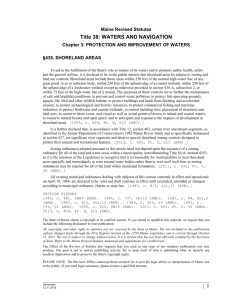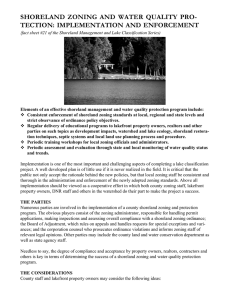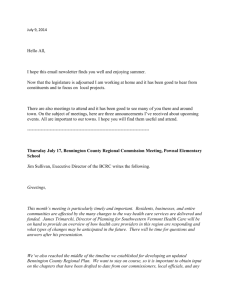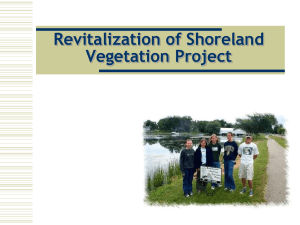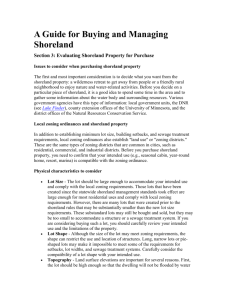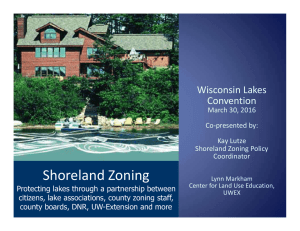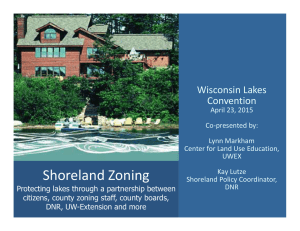Does shoreland zoning work? How does this study relate to Wisconsin?
advertisement
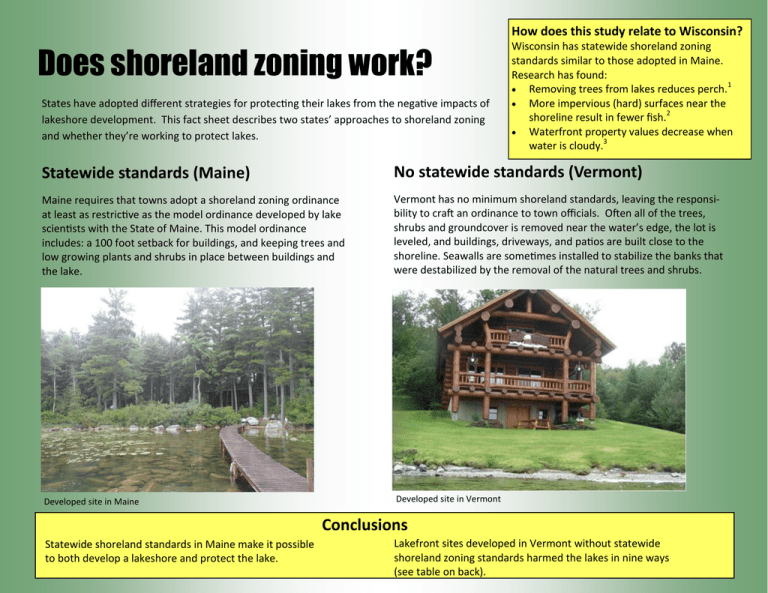
How does this study relate to Wisconsin? Does shoreland zoning work? States have adopted different strategies for protecting their lakes from the negative impacts of lakeshore development. This fact sheet describes two states’ approaches to shoreland zoning and whether they’re working to protect lakes. Wisconsin has statewide shoreland zoning standards similar to those adopted in Maine. Research has found: 1 Removing trees from lakes reduces perch. More impervious (hard) surfaces near the shoreline result in fewer fish.2 Waterfront property values decrease when water is cloudy.3 Statewide standards (Maine) No statewide standards (Vermont) Maine requires that towns adopt a shoreland zoning ordinance at least as restrictive as the model ordinance developed by lake scientists with the State of Maine. This model ordinance includes: a 100 foot setback for buildings, and keeping trees and low growing plants and shrubs in place between buildings and the lake. Vermont has no minimum shoreland standards, leaving the responsibility to craft an ordinance to town officials. Often all of the trees, shrubs and groundcover is removed near the water’s edge, the lot is leveled, and buildings, driveways, and patios are built close to the shoreline. Seawalls are sometimes installed to stabilize the banks that were destabilized by the removal of the natural trees and shrubs. Developed site in Maine Developed site in Vermont Conclusions Statewide shoreland standards in Maine make it possible to both develop a lakeshore and protect the lake. Lakefront sites developed in Vermont without statewide shoreland zoning standards harmed the lakes in nine ways (see table on back). Can we develop a lakeshore and protect the lake?* 9 measures of lake health Statewide No statewide shoreland shoreland zoning zoning standards standards (Maine) (Vermont) Shoreline trees Large woody structure Medium woody structure Small woody structure Leaves in the water Variety of lake bottom types, not covered in sand Structure not covered in sediment Why are these measures important? Trees, shrubs and ground cover near the shoreline provide: Erosion control Shade in water near shore Food for deer and other wildlife Fallen trees in the water (woody structure) provide: Cover for fish to hide from birds and bigger fish Places for turtles to bask in the sun to digest their food Structure where frogs attach their eggs Leaves in the water feed water insects (fish food) Lake bottoms not covered in sand & sediment provide: Valuable nesting sites for fish, where their eggs aren’t buried Habitat for water insects (fish food) Small animals and plants growing on structures Small animals and plants growing on rocks and other structure provide food for fish, snails and other animals Dragonflies & damselflies Dragonflies & damselflies rely on healthy shorelines & lakes and are voracious predators of mosquitoes Full report: Determining if Maine’s Mandatory Shoreland Zoning Act Standards are Effective at Protecting Aquatic Habitat, March 14, 2013 by the Vermont Department of Environmental Conservation. www.anr.state.vt.us/dec/waterq/lakes/docs/lp_mainezoning.pdf *In the table, a checked box means there was no significant difference (α =0.05) between the developed and reference (undeveloped) lake sites, while an unchecked box means there was a significant difference between the developed and reference (undeveloped) lake sites. References: 1 Helmus, M., & Sass, G. 2008. The rapid effects of a whole-lake reduction of coarse woody debris on fish and benthic macroinvertebrates. Freshwater Biology , 53, 1423–1433. 2 Garrison et al. 2008. Implementation and interpretation of lakes assessment data for the Upper Midwest. Final report to the U.S. EPA. 3 Krysel et al. 2003. Lakeshore property values and water quality: Evidence from property sales in the Mississippi Headwaters region.


